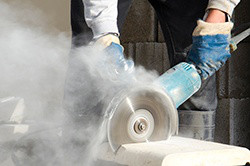 OSHA has issued a final rule to protect workers from exposure to respirable crystalline silica. It is comprised of one standard for Construction and one for General Industry and Maritime.
OSHA has issued a final rule to protect workers from exposure to respirable crystalline silica. It is comprised of one standard for Construction and one for General Industry and Maritime.
By limiting workers' exposure to very small, or respirable, particles of crystalline silica, this rule intends to curb lung cancer, chronic obstructive pulmonary disease, kidney disease, and silicosis, an incurable lung disease which can lead to disability and death. Once the changes are fully implemented, OSHA estimates over 600 lives to be saved and more than 900 new cases of silicosis prevented each year.
Approximately 2.3 million workers are exposed to respirable crystalline silica at work. This includes 2 million construction workers who drill, cut, crush, or grind silica-containing materials such as concrete and stone - as well as 300,000 workers in general industry operations such as brick manufacturing, foundries, and hydraulic fracturing.
As an employer, you have a responsibility to protect workers from harmful exposure to respirable crystalline silica.
What Are The Key Provisions?
OSHA outlines the following key provisions of the final rule:- Reduces the permissible exposure limit (PEL) for respirable crystalline silica to 50 micrograms per cubic meter of air, averaged over an 8-hour shift.
- Requires employers to:
- use engineering controls (such as water or ventilation) to limit worker exposure to the PEL;
- provide respirators when engineering controls cannot adequately limit exposure;
- limit worker access to high exposure areas;
- develop a written exposure control plan;
- offer medical exams to highly exposed workers; and
- train workers on silica risks and how to limit exposures.
- Provides medical exams to monitor highly exposed workers and gives them information about their lung health.
- Provides flexibility to help employers - especially small businesses - protect workers from silica exposure.
What Is The Schedule For Compliance?
Both standards take effect June 23, 2016. Industries will then need to comply with most requirements based on the following schedule:
- Construction- June 23, 2017*
- General Industry and Maritime- June 23, 2018
- Hydraulic Fracturing- June 23, 2018 for all provisions except Engineering Controls, which have a compliance date of June 23, 2021
To read the final rule, an overview, FAQ, and other resources, visit: www.osha.gov/silica
*The enforcement of the respirable crystalline silica standard for construction has been delayed until September 23, 2017 by OSHA. Click here to see the memorandum.



